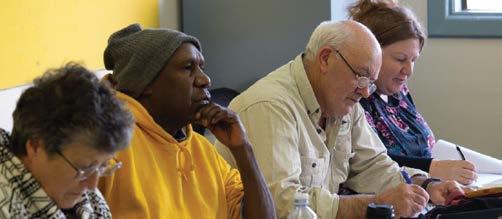
35 minute read
First Aboriginal Minister for Indigenous Australians
Country Arts SA hosts retreat for emerging Aboriginal writers
Emerging Aboriginal writers spent four days on picturesque shores of Lake Alexandrina, to hone their craft under the guidance of playwright Nathan Maynard and writer and theatre maker Alexis West.
Advertisement
The writer’s retreat, hosted by Country Arts SA, provided artists with a culturally safe space to write, develop new skills and hear feedback and advice on their previous work. In addition to the workshop, participants were treated to a cultural tour of traditional Ngarrindjeri land with local Elder Uncle Clyde Rigney.
Participants Chris Crebbin, Tanya Sheree O’Leary and Danielle James said the experience helped them on their writing journeys.
Mr Crebbin said the retreat was “enlightening, inspirational and informative. I feel I have direction for my storytelling”.
Ms Sheree O’Leary said “The retreat was amazing. I can’t believe how much information there was and I still am surprised to be lucky enough to be chosen. I would love to pass on my knowledge to others; either my kids or whoever will listen”.
Ms James said she hoped “to learn how to structure a play and learn about the writing process; to build confidence with my writing”. She said the experience encouraged her to keep on writing.
“It was a fantastic location and accommodation. The food was excellent, and I really appreciate the community warmth and effort into caring for us. The learning was enormous, and the facilitators were enthusiastic, professional and highly knowledgeable. (The retreat) has clarified that I have a story to tell and given me structure on how to formulate it” she said.
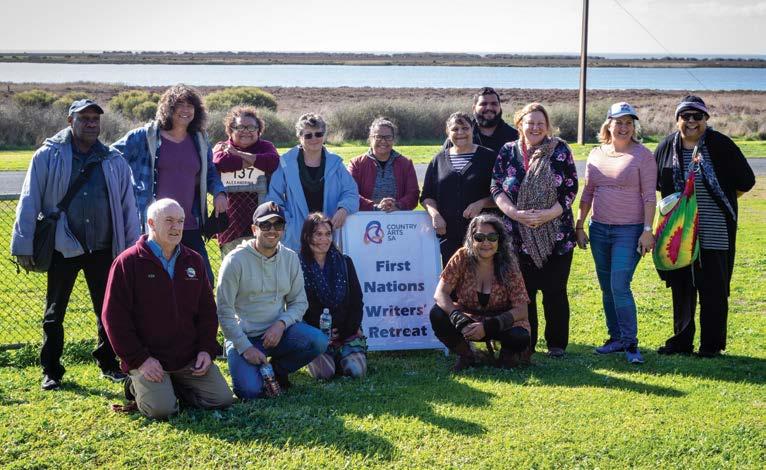
Histor y in the making with first Aboriginal Minister for Indigenous Australians
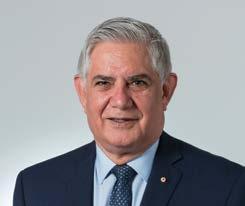
Noongar man Ken Wyatt has been appointed Minister for Indigenous Australians, making him the first Aboriginal person to be appointed to the Indigenous affairs portfolio. He has quickly put constitutional recognition on the table, promising to work towards a vote on recognition in the Government’s current term.
In a statement Minister Wyatt said he was “incredibly honoured to be the first Aboriginal minister for Indigenous Australians, committed to working and walking together with our elders, families and communities, to ensure the greatness of our many nations is reflected in the greatness of the Australian nation, now and forever”. Minister Wyatt is the oldest of 10 children. His father, Don Wyatt served in the RAAF at the end of world war II as a driver and worked for the Western Australian Government Railways for most of his life. His Mother, Mona Wyatt was one of the Stolen Generation and spent her childhood in Roelands Mission near Bunbury in Western Australia. In his maiden speech, Minister Wyatt addressed the apology to the stolen generation and said it was an integral part of our nation’s healing and recognition of past wrongs. “The apology to the stolen generation has been a powerful instrument in the healing of both our people and our nation. The apology was acknowledged and received in the spirit for which it was offered... On behalf of my mother, her siblings and all Indigenous Australians, I, as an Aboriginal voice in this chamber, say thank you for the apology delivered in the federal parliament and I thank the Hon. Kevin Rudd for honouring his commitment to the stolen generation” he said. The Minister said he is committed to establishing educational pathways for young people, working with Aboriginal communities for better outcomes and for a more inclusive Australia.
“I am passionate about and strongly committed to working towards achieving better outcomes and opportunities for… Indigenous Australians and Australian society marked by justice, legitimacy, integrity. “I strongly believe that we need to provide a lifelong educational pathway that positions our young people to succeed in an ever-changing world where the quick pace of the global and technological society will be ever-present in their lives… [and to] provide strong and visionary leadership that forges our place in the global community as a nation of people led by many, not the few.” Three days before the Election Day, Minister Wyatt said that the Morrison Government was committed to forming a ‘Voice to Parliament’ after allocating $7.3 million in the 2019–2020 budget for a ‘co-design of options’ though it’s unclear what exactly that would involve.
“This is not about singling out Aboriginal or Torres Strait Island people or affording them extra rights above all other Australians. This is about correcting the contextual silence that is currently so deafening in the constitution” he previously told NITV. On Wednesday 10 July, Minister Wyatt announced to progress a referendum to recognise Aboriginal and Torres Strait people in the Constitution.
“I will develop and forward a consensus option for constitutional recognition to put to a referendum during the current parliamentary term. That means working through until we reach a point in which there is consensus across all the relevant groups who have a stake in it.”
The Minister said it is important not to rush a referendum and more engagement will need to be done.
“I do not want to proceed if we are not going to be successful. I have commenced the process of engaging and seeking the counsel of Indigenous leaders on the best way forward… The Morrison Government is committed to recognising Indigenous Australians in the constitution and working to achieve this through a process of true co-design. Constitutional recognition is too important” said Minister Wyatt.
“He was a Nukunu man, in what he described as the Mount Remarkable tribe. In the field tape, he’s recorded as saying this. “I was brought up by my grandmother Mary, she was pure Aboriginal. Her own parents were frightened when they saw the first white man, thought it was a ghost. It was when some crew from a ship came up on the hills.”
“It’s likely that the ghosts that Mary’s parents saw, were the crew from a ship that was navigated by Captain John Germein. He was a pilot of ships, that were owned by the South Australia Company. This state was founded by a company, as a commercial enterprise, in western terms, in terms of European history.
“That first contact would have occurred sometime in the 1840s, and from then European settlement and expansion in this area spread out from Crystal Brook, swiftly and with devastating consequences for the traditional owners.
Justice Charlesworth also spoke about the impact of land clearing and farming on the Nukunu people and culture.
“By the turn of the 20th century, so much land had been cleared and settled, that there could be at any one time, 10 or more international ships out there at the end of that jetty. Taking wheat, cargoes of wheat, 42,000 bags of wheat on one ship alone. That’s some commercial achievement, when looked at through a western view of history. You are entitled to view that history somewhat differently. “The volume of bags gives an indication of the volume of land cleared. Imagine the size. This institute was built in 1892, on Nukunu country. I hazard to guess the Nukunu people weren’t asked for permission when that was done. By that time the numbers of Nukunu people still living in the area had diminished drastically.
“There was a very sharp decline in the population of the Nukunu living in this area, at the same time the land was apportioned into pastoral leases and other holdings. It was criss-crossed with boundaries, and borders. The gorges were gouged through with roads. Stock came and trampled. Salvation Jane rolled out, like a bruise coloured carpet over Nukunu land” she said
Justice Charlesworth also spoke about later dispossession of Nukunu people from their country.
“It’s difficult to have that conversation without referring to places like Point Pearce, Point McLeay, and the purposes for which those places were established, ostensibly for protective purposes.
“Of the people at Port Pearce, Harry Bramfield was recorded by Catherine Ellis as saying this. ‘They came from different places, collect them all up, send them to Port Pearce, Point McLeay and places like that, and my father, he was collected from a place called Bramfield on the west coast. That is why he and mum were different.
“The dispossession of Aboriginal people, their collection, to use Harry Bramfield’s words, had consequences for your traditions, and your customs, and your language, and your survival.
“So, if it be acknowledged, that the eastern portion of the determination area was probably Nukunu country, its sovereignty that it must follow, that the loss of connection to that country, is probably attributable to dispossession of the people, their relocation and consequent dislocation from each other. All of this combined in a catastrophe wrought by European contact” Justice Charlesworth said to the people gathered for the handing down of the determination.
One of the original claimants in the Nukunu native title application, Rose Turner spoke about the long native title process after being presented with the written court decision.
“It’s been a long battle. I’ve been a named claimant since the jump off. This brother of mine nominated me at a community meeting to be one of the named claimants, and it’s been a long, hard battle. It’s not just been with government, it’s been with mining companies, oil companies, them wanting to put a nuclear facility up here. But hopefully this will put us in a better position to negotiate with interested parties” Ms Turner said.
Outside the hall following the hearing, Nukunu elder and claimant Lindsay Thomas spoke to local media about how he felt about the finding. “It’s just a happy day for me. It’s a relief that the stress is all gone. It’s such a long, long fight, and we got there in the end.
“We never thought we was going to because we are such a small group.
“I’m as happy as hell to tell you the truth. I’m not quite showing it but inside, you get to think on what we went through to get here. It’s just a long time and a big part of my life. But now it’s worth it. I’m still young enough to enjoy my country here.”
Mr Thomas also spoke about Nukunu plans now that the native title claim was settled.
“What it means to us is that we can now actually rehabilitate our lands. And the waters, we’ve already started planting remnants that were here originally. And we’re also looking at the oyster reefs, to bring back the waters, to clean them again, and bring back fish species to the waters. We’ve got enough skilled people in our groups to actually move forward there.”
Mr Thomas also reflected on what the determination means for the next generation of Nukunu people.
“It means a whole new thing for them because they did understand the native title fight and what it meant. Along with the Elders, they went though the hard times with them. So their grandparents and their great uncles dying. That means a great deal to them now because they know that they’ve got control of their destination now. And we will encourage others as the older Nukunu, we will encourage them all the way” Mr Thomas said.
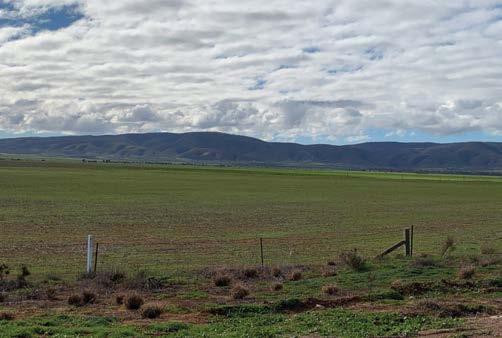
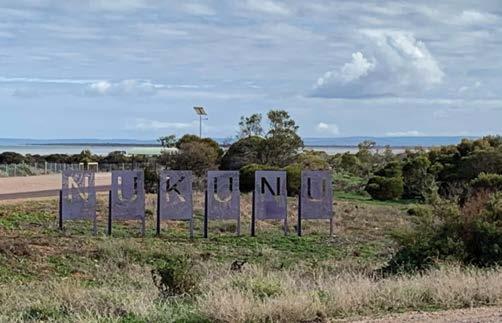
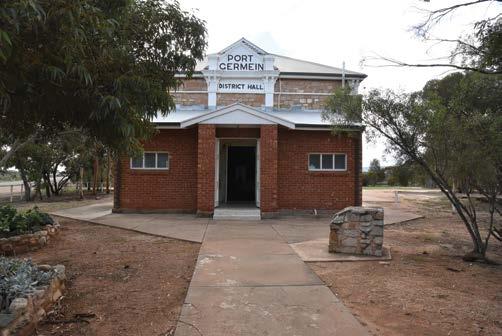

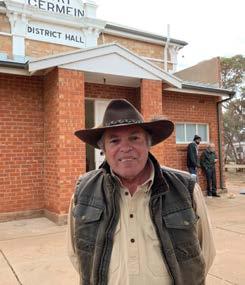
Above: Lindsay Thomas outside the Port Germein and Districts Hall on Nukunu country on the day of the Determination hearing.


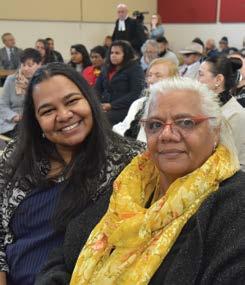
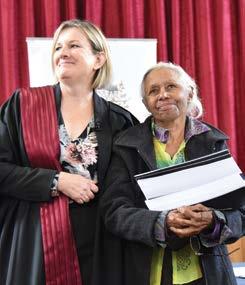
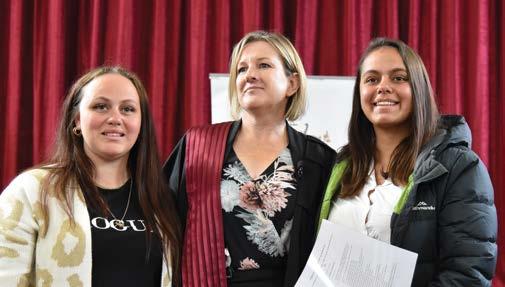
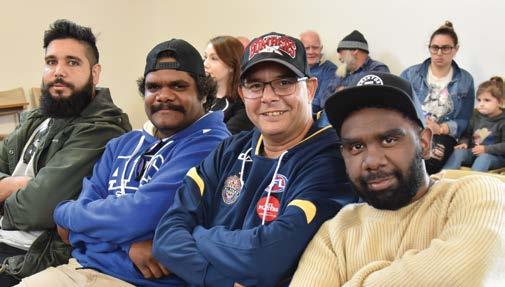
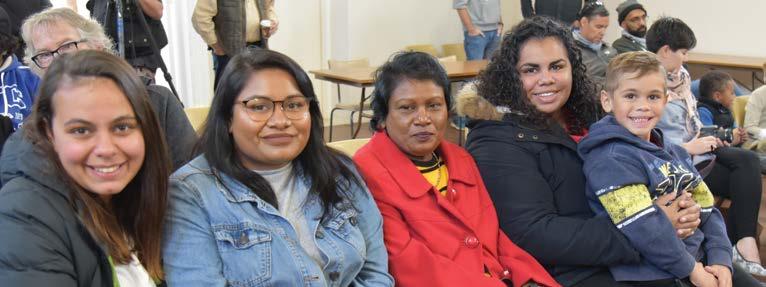
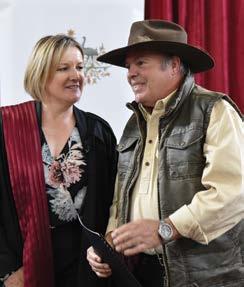
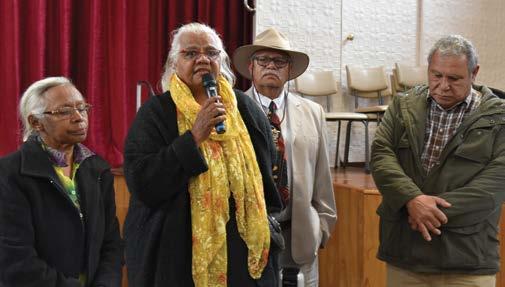
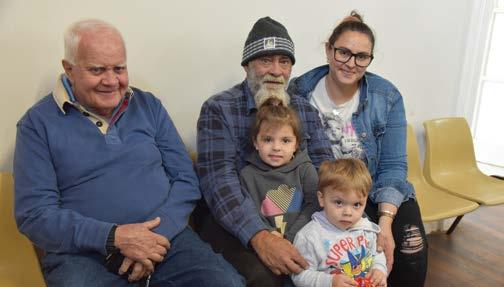
Above, left to right from top left: John Turner, Darcy Edwards, Jared Thomas, Beth Turner, Rose Turner, Lindsay Thomas and Michael Turner; Michael Turner, Maxine Turner with children Jeffrey and T’yirah; Beth Turner with daughter Sarojni Samy; Justice Charlesworth and Rose Turner; Georgia Turner, Justice Charlesworth and Lauren Turner; Mark Giles, Nathan White, Trent Turner and Michael Turner; Lauren Turner, Anarla Turner, Sunda Turner, Jessica Turner and William Sambo; Justice Charlesworth and Lindsay Thomas; Rose Turner, Beth Turner, John Turner and Michael Turner; Sid Lee, Scott Russell, Alexandria Constance, Charlie and Jaylah.
The Kaurna man with a plan: Paul Herzich tells his stor y at Reconciliation Week
As guest speaker at the Reconciliation in the North Morning Tea, Kaurna/Ngarrindjeri Man Paul Herzich, shared part of his life journey from a young boy growing up in Port Pirie to becoming a renowned landscape architect and visual artist in Adelaide.
Paul spoke to Aboriginal Way after the Morning Tea.
Could you tell us about what it means to be a landscape architect and how you incorporate your cultural ideas and into your landscaping?
My Mum, Dianne Herzich has always had a real green thumb. She has an amazing talent of getting any plant to grow anywhere and really well. I guess her love for plants rubbed off on me somewhere along the line, as I have now been in the landscape industry for over 30 years and a registered landscape architect for 14 years. For me, incorporating culture into landscapes is about educating people about the underlying layer of the landscape. There’s so much more to the landscape than buildings, roads, paddocks and fences. There’s a lot more history and culture out there. So, for me it’s about recognising and acknowledging country, culture and people. As well as providing an opportunity for people to gain a better awareness and appreciation of our main Aboriginal language groups within the state of South Australia.
In the Adelaide Centre, how have you, with your projects, been able to express the Kaurna culture?
I have created a lot of cultural markers that acknowledge and recognise Kaurna culture in the time periods of pre-colonisation, colonisation and postcolonisation. I like to place reminders of our culture in many forms around the city for all to experience and enjoy.
I love the poem that you shared with us and the way that you explained what it would have been like to be here with no concrete jungle. Is that the type of feeling that you’re trying to get through with these visual markers?
That’s right! I like to try and get people to have a break from their everyday life away from the concrete, the roads and buildings and all those kinds of things and try to temporarily take them to another place that is seen with their mind’s eye. For that poem, I found myself a nice secluded little spot with no interference and sat down on a bank of the Karrawirra pari/River Torrens just before the sun came up and the poem reflects what I saw, what I felt and what I wanted to express in the project. I wanted to create an experience of what it would have been like to walk in the ancient 65,000 year old footsteps the Kaurna people prior to colonisation. Tell us about how you got connected with your Aboriginal culture, early on. Growing up in Port Pirie, as a kid, we didn’t know that we had Aboriginal ancestry. We knew we were of German descent, who were amongst the first groups of Lutheran settlers in 1838 and that’s about it. When looking at physical features of my Dad, Fred Herzich and some uncles and aunties, my Mum who is pretty cluey with these sorts of things, thought we could be of Aboriginal descent. But it wasn’t until about 1984 or 85, I think, where all of a sudden we found our Kaurna/Ngarrindjeri family connections through the Link-up Program. My Dad’s Mum, although passed away in the very early 90s, was a Stolen Generation survivor. She was born at Meningie in the 1920s and four years after forcibly removed from her family and fostered out from Raukkan and lived in Glenelg East to ‘assimilate’ with a nonAboriginal family. When she was 18 or 19, she moved up to Port Pirie – got married and had 10 children. So, once we found out our connections, there were cousins galore and the family was re-united. I started getting involved in Kaurna culture with my landscape design and visual art projects in the early 90s and I have got to meet a lot of the Kaurna community as well through different projects over the years, which is great. The majority of Kaurna people have open arms and my keen involvement with helping to keep the Kaurna culture alive has basically gone on from there. I’m still learning my Aboriginal culture. For instance, I don’t fully know the Kaurna language, I don’t really know if I ever will, but obviously we all have different strengths and weaknesses and at the end of the day, we are all Kaurna people, we are still here and we all bring something different to the table.

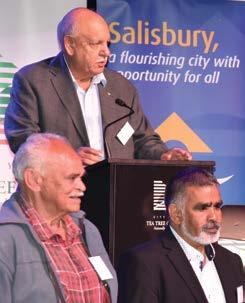
Paul’s Poem – No concrete, vehicles, or buildings
Imagine a place with no concrete, vehicles, or buildings. As the sun rises over the ranges, the sky changes colour. The treetops turn from black to green. As the fresh air gently blows across your face, flocks of rosella fly by screeching. The crow can be heard in the distance. The magpies warble their morning song. The buzz of a fly buzzes past from left to right. The kookaburras laugh in the gum trees.
The smell of campfire smoke drifts across the crisp morning air. Kangaroos can be seen in the distance feeding on the fresh green grasses. Emus can be seen foraging for food as well. Ducks paddle across the river on their morning swim. Fish break the water’s surface feeding on insects, and sacred kingfishers dart from here to there. Voices appear across the landscape with early morning mouths to feed. The smell of gum tree blossoms fill the air.
The sun is now setting. It lights up the sky with reds, oranges, and yellows. Its golden hue now glows across the landscape, for its final glimpse above the horizon is near. The campfires are now raging with strong crackling sounds. The Kaurna men, women and children have been successful during the day, for everyone will feast tonight. As owls, crickets, and possums begin to stir, the moon slowly rises above the ranges and lights up the land. Everyone sleeps tonight, for tomorrow is another day, another day without concrete, vehicles, or buildings.
What is your focus when designing a landscape or art installation?
A strong focus is to incorporate Aboriginal themes and identity into my installations for the present and for future generations – even for those who haven’t been born yet. My intent is to provide people with a resource and an understanding of aspects of Aboriginal culture. I also like to include native plants that were used for various cultural reasons, so that knowledge and lessons can be handed down to people.
What would you like to see happen in the Adelaide centre to enhance this idea of cultural markers and teaching people about this area pre-colonisation?
I would like to see the Kaurna Art Trail built upon throughout the city of Adelaide. It would be great if every park land had a Kaurna cultural marker in it and they could be accessed by a shared path that link them all up. I’d like to see some cast bronze sculptures of our Kaurna Elders around the city. We have ones of Queen Victoria and Colonel William Light and the one of Mo in Hindley Street. I’d love to see our Kaurna Elders recognised in that same regard and form too. I would also love to see some new major roads or buildings, or something named after our Senior Kaurna Elders. It would be great if they were named after Elders that are alive today, so they can see it and enjoy it. So is that how you see ‘reconciliation’ visually? For me reconciliation about learning about our culture – we are the oldest culture on earth and I believe we should be highly respected for just that bit alone. Some people say “Oh, it’s just a weeklong celebration for Aboriginal people”, well no, it’s a week for everyone to come together, to share and celebrate our history, become aware of our culture through discussion and activities. We’ve become aware of who non- aboriginal people are and their cultures. For me it’s about just getting along together and moving forward for future generations. You know, it’s not just all about us. It’s really for people of today setting up a future for the next generations.
Have you got any advice for any young ones out there that are wanting to get involved in visual art and landscaping? Well, I always recommend to give a few different jobs a go while you are young before setting your heart on that one thing. Work out what you’re good at, work out what you’re not! Choose something that you’re comfortable with and that you love doing – you’ll never work a day in your life… Choose something you want to get out of bed and go to. If you start to think that you couldn’t be bothered going to work today, well that could mean that job is not really for you. I always recommend getting on a relevant work related committee. They are a great way of networking with like-minded people. I also recommend to never doubt yourself. Just be confident and get amongst it and give it your best.

A state parliamentary committee has recognised a ‘widespread desire’ from Aboriginal communities to have greater control over their land, including the Aboriginal Lands Trust returning land to community control. While the committee recognised the desire for change, it also stated that “there still needs to be a level of protection so the land is not put at risk”. It has recommended an independent inquiry into Aboriginal land ownership across the state.
The Parliament of South Australia’s Aboriginal Lands Parliamentary Standing Committee has completed a review into the operations of the Aboriginal Lands Trust Act 2013. The Aboriginal Lands Trust is the body that manages some areas of land held in Trust for Aboriginal communities under that Act.
South Australian Native Title Services (SANTS) submitted a written submission to the review and Chief Executive Officer Keith Thomas also addressed the Committee. In speaking to the Committee, Mr Thomas said that Trust land exists within several native title determined areas in the state, including Ngarrindjeri, Antakirinja Matu Yankunytjatjara, Adnyamathanha, Far West Coast, First People of the River Murray and Mallee, Barngarla and Kaurna peoples’ country.
SANTS believes that divestment of ALT lands to native title groups is desirable and that the ALT Act 2013 should be amendment to establish suitable ways for this to occur.
Mr Thomas said that the pieces of legislation around native title and Trust lands in South Australia are not complementary and can’t co-exist successfully within the complex legal frameworks that surround them. That can leave Aboriginal people directly involved confused and in some instances in conflict with each other, he told the Committee.
Mr Thomas said that native title group’s corporations, Prescribed Bodies Corporate (PBCs) are the drivers of social, cultural and economic participation and provide the foundation for an ALT return of country to native title holders and claimants.
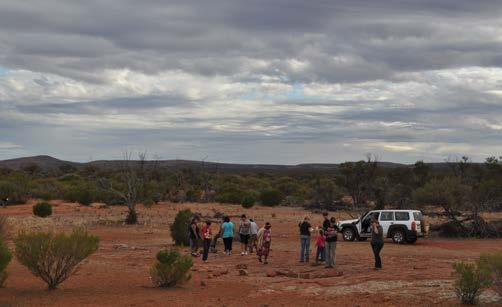
The divestment of the lands currently held the by the ALT is consistent with the principles of self-determination Mr Thomas said.
SANTS will continue to participate in any reform to this area, with the aim of supporting traditional owners and Aboriginal communities to achieve sustainable nations.
The Report of the Aboriginal Lands Parliamentary Standing Committee’s Review into the Operations of the Aboriginal Lands Trust Act 2013 is available on the Parliament of South Australian website: www.parliament.sa.gov.au
NAIDOC in the Mall
The annual NAIDOC in the Mall took place on Tuesday 9 July at the Gawler Place canopy. The event included a Kaurna Welcoming Ceremony conducted by Jack Buckskin followed by the unveiling of this year’s artwork. Entertainment followed, including a performance by the Deadly Nannas.
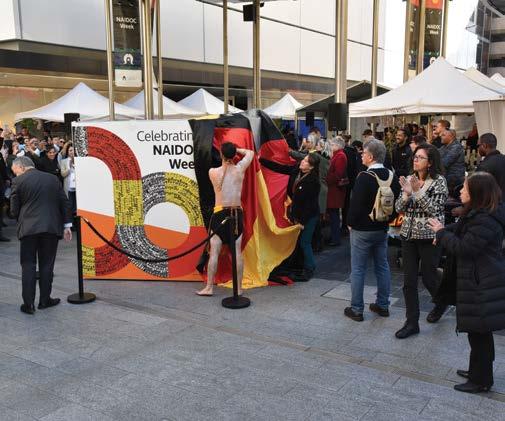
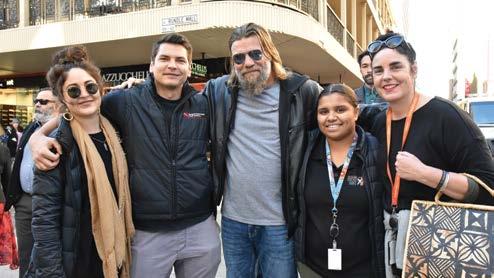
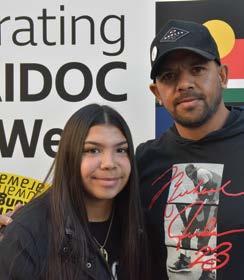
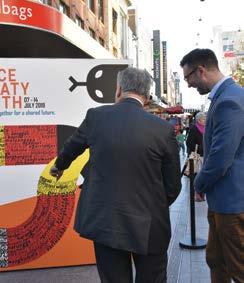
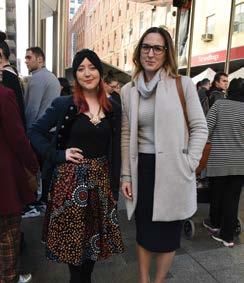
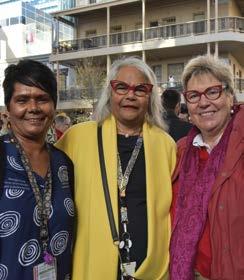
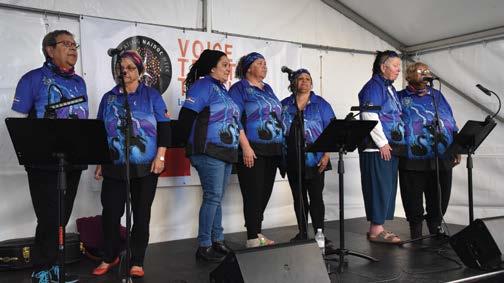
Above, left to right from top left: NAIDOC artwork is unveiled; AHCSA staff Annabella Marshall, Tallulah Bilney, James Bisset, Joshua Riessen, Hannah Keain; Shakari Davis and Leon Davis; Minister Stephen Wade and Councillor Robert Simms; Lizz Kerr and Anita Kuch; Roxanne Sambo, Jo Wilmott and Joylene Thomas; The Deadly Nannas perform.
In one of South Australia’s leading health research organisations, work is being done to find better ways of dealing with one of the most common chronic health conditions in the Australian population broadly and the Aboriginal community particularly – diabetes. The SA Aboriginal Chronic Disease Consortium, which is based at SAHMRI is taking a careful evidence-based and community-led approach to help Aboriginal people better live with diabetes.
Project officer Douglas Clinch is a Ngarrindjeri Yamatji man who is working with the Consortium. He is currently developing a video series which features Aboriginal and Torres Strait Islander people telling their personal stories of living with diabetes. This approach to diabetes education is all about identifying and using language that people can relate to, he explained why to Aboriginal Way.
“We’ve received funding to create resources from Country SA Primary Health Network, they’re really interested in having some resources created for the Aboriginal community that uses language and terminology that the Aboriginal community understands, therefore making them culturally appropriate” Mr Clinch said.
The project team wants to include personal experiences from Aboriginal community members around both challenges and successes that they’ve had in managing their diabetes. They also want to record the stories of people who may not be diabetic, but have been able to change their lifestyle knowing the risks that are involved with diabetes.
“That really does inspire other community members to take hold of their own management of their health and diabetes and also to be more informed about this very complex disease” Mr Clinch said.
Information is key in managing this complex disease and Consortium staff believe that Aboriginal engagement in the development of information resources is crucial. “A lot of the resources that are out there, I’m sure they would have had Aboriginal engagement in the production of these resources, but we felt like sometimes the language that is used is not really understood by community.
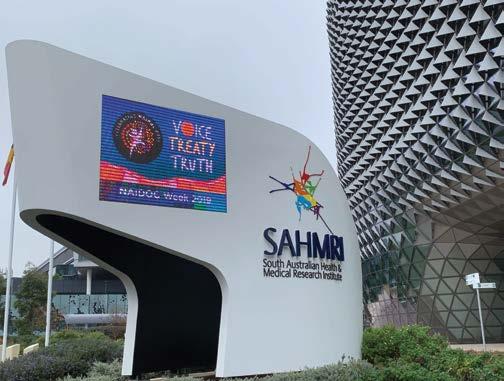
“Particularly if education levels aren’t to a high level or if English is the second or third, even fourth language spoken by these communities” he said.
“Quite often the people that would have a better understanding of this disease and are able to speak to it are the people that have diabetes” Mr Clinch said.
The videos developed from the personal stories will include a range of information, with topics developed by a working group of community members.
“What we’ve tried to do is we’ve got a working group that’s helped us think about how we go about implementing this project but also how we would break down the diabetes into its different components” Mr Clinch said.
“Things like firstly explaining what diabetes is and how that impacts on the body and the system of the body. Then we’d like to talk about how to minimise the risks around diabetes, so things like nutrition, exercise, getting your assessments and checks regularly around the eyes and feet and things like that, and blood flow.
“We’ve also got medication, so we’re wanting to explain that it’s important to keep up with your medications, that they’re taken at the right time of day, in the right context, whether it’s with or without food and things like that.
“Hopefully, we’re looking to do maybe around 10 to 12 videos that really do break down the disease and explain it in a way that is comprehensive” Mr Clinch said. The approach being taken for the development of diabetes resources reflects the way the Consortium likes to do its business across the major health issues of heart health, cancer and diabetes, Mr Clinch said.
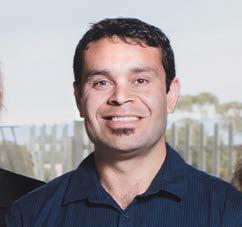
“A priority of ours is to make sure our community are front and centre of everything that we do. Within our governance structure, we’ve got a community reference group and all of the activity that we propose to undertake in the Consortium is fed through the Community Reference Group.
“We need to have their lens applied to everything that we do and we need to be sure that the way in which we go about implementing and putting into place our research is done in a way that is acceptable by the community and done in an appropriate way.
“The community is very important to us and they’ve really led our work right from the beginning. A lot of our principles, our guiding principles around how we do implement our work has been heavily influenced by our community reference group and so that’s something that we’re really proud of” Mr Clinch said.
For more information on the diabetes videos project: Douglas Clinch – 8128 4893, douglas.clinch@sahmri.com
See more about the Consortium here: aboriginalhealthconsortium.org
Ancestral remains uncovered in Berri
Aboriginal ancestral remains that were uncovered during water main replacement works in Berri have been reburied under the guidance of the area’s native title holders, the the River Murray and Mallee people.
Following discovery of the site in Berri, SA Water’s contractors immediately stopped work and contacted the South Australian Police to help with identification. SA Water then worked together with the the River Murray and Mallee people to plan a way forward.
SA Water’s Aboriginal Heritage Engagement Advisor Ben Denison said the reburial work involved the recovery of remains by hand and careful reburial at a deeper depth by machinery.
“A protective layer of sediment and concrete was also placed overhead, and the site was recorded on the official state register to ensure any future works by any party don’t cause any further disturbance” Ben said.
“This decision and process was very much driven by the local Aboriginal community, and we just made it happen.”
Chairperson of the River Murray and Mallee Aboriginal Corporation Sheryl Johnson said when an ancestral burial is uncovered, it can be quite painful for the community, so making sure that Old People are either returned to their original resting place or moved to another location of their community’s choosing is a vital step in the healing process.
“We believe that when our people are buried, they shouldn’t be disturbed, so obviously we would prefer if discoveries like this one at Berri didn’t occur” Sheryl said. “SA Water supported us in this repatriation, and a Smoking Ceremony occurred as a sign of respect and cleansing of all involved, as well as to promote the wellbeing of our people and guests on our Country.
“Especially for the non-Aboriginal community, I think it’s easy to just see buildings and roads when you look around our state, but for my people, there’s a deeper embedded history, and this needs to be respected.”
For all of its major site works, SA Water carries out a heritage assessment with relevant Aboriginal communities and heritage experts to identify the level of risk of encountering any objects of cultural significance. This is based on proximity to known sites or landscape features such as sand dunes or water sources, and general history of the area. “This informs a management plan, which may result in changes to project design or having heritage monitors on site during works to make sure our activities are managed in a culturally-appropriate and sensitive manner” Ben said.
“Sometimes though, even the best laid plans can’t predict what’s below the ground and where it is. In my experience, this is an extremely rare occurrence, but unfortunately our water main works on this occasion did impact local Aboriginal heritage. “As an Aboriginal man, I recognise the importance of respecting our ancestors, so I apologise to the custodians of the land. “Respect is a key focus of our Reconciliation Action Plan and we’re committed to delivering on this in all areas of our business and ongoing work with Aboriginal communities” Mr Denison said.
A community forum held at the SA Museum has heard that the city of Adelaide needs a strong suicide prevention network specifically to support Aboriginal people. Suicide prevention networks are a key element of the South Australian approach to suicide prevention and networks exist across the state.
However, there is not a strong network focussed on Aboriginal people in the city, suicide prevention advocate and ALRM staff member Frances Jacobson told Aboriginal Way after the community event. “I think that considering the numbers, the statistics about Aboriginal suicide, and then the harsh environment of the city, that it’s really important to be able to support people who are either living in the city, or maybe working in the city, but somebody who needs a group that they can hook into in the city. “It’s important to have Aboriginal networks to create culturally safe spaces” said Ms Jacobson.
“Because to be honest, there are very few of us who are not impacted by suicide generally, and within the Aboriginal community, it’s about times 18 more prevalent than in the general community” she said. Those attending the community forum were touched and inspired by a powerful speaker who is familiar with issues relating to indigenous people and suicide, former NRL player Joe Williams. He says that suicide in Indigenous communities can have very specific causes.
“Well, with our communities, a lot of issues that we are struggling with relate to a disconnection of spirit” he told Aboriginal Way. “In a word, I can relate to it as hopelessness. We are seeing a lot of people in communities that just don’t see a light at the end of the tunnel. That’s because of a couple of hundred years of oppression and being told that you’re not good enough” he said. In his work speaking on resilience and mental health, Mr Williams calls for a new approach to Aboriginal suicide. “We’ve got to have a look at the different ways to be able to heal that, because the western mainstream white model of medical healing, when it comes to mental health issues and conditions, isn’t working. If our suicides are going higher, it’s not working. “We’ve got to get back to a perspective of community empowerment and facilitating a community led approach to be able to look at healing within our communities and then that’s when we get the support from the experts and the outside help from community” he said. The Adelaide metro network is working towards just that, a community led approach said Ms Jacobson. “It appears to me that the general model for suicide prevention networks is a committee of professional workers who then organise events for community. People, consumers, come to those events and participate in them. Sometimes they’re the guest speakers, sometimes it’s just an event for community. “I had advice from an elder who said, ‘it’s not supposed to be about service providers, it’s supposed to be about the community. You need the group to be community members. “There was a lot of discussion about wouldn’t it be fantastic if the groups were actually community led, run, and owned. And they invite the service providers, rather than the other way around. So that’s our ultimate goal” she said. “A strong community-led support group can be a powerful thing for someone in crisis” Ms Jacobson said.
“One of the major things is this idea of belonging, and so these events create a space for people to come where it’s safe to be bereaved, where it’s safe to talk about suicide. And because this one will be an Aboriginal group, that in itself creates an amount of safety in terms of talking, yarning, having an outlet. Attendees of the community forum in May talked through ideas for the way the network could operate.
They indicated that they would like to be part of a network which has good governance principles, where Aboriginal values and culture inform decision making, which includes the establishment of clear group norms and maintains consultation with Aboriginal elders and leaders.
“Flexibility, commitment and evaluation were some of the other themes to emerge and there were quesitons raised about where the meetings would be held” Ms Jacobson said.
It’s all about making safe spaces to talk. Mr Williams is also a strong believer in the importance of yarning in suicide prevention.
“The reason, I think, why there are quite significant men of hurt and trauma, and the end result is suicide in our communities, is because we don’t talk about it. The one way to heal these types of issues that we’re struggling with inside our mind is to start to verbalise it, and get it out in the open, and let’s have a look at it from a different perspective.
“Instead of trying to deal with it inside our heads, by ourselves, which obviously a lot of the time compounds to make it bigger, and nastier, and more threatening, once we get it out of our heads, verbally, we start to have a look at it from a different perspective and start to have a look at what the issues are, and how we can address them” Mr Williams said.
“Aboriginal Legal Rights Movement (ALRM) is playing a strong role in the development of the network as it fits with the core work of the ALRM” said Ms Jacobson.
“Thinking about what it is that ALRM does, actually almost everything we do is suicide prevention. We see the high risk factors for suicide on a daily basis. Pending criminal matters, family dispute, lack of interpreters, financial crises, incarceration, they’re all in the top 10 of the stresses in people’s lives. “People who are incarcerated often feel like there’s very little meaning in their lives.
“When we feel like there’s no reason for us to be here, and our lives are meaningless, that’s when suicidal thoughts might begin to impinge sometimes for some people.” Despite the challenges, Ms Jacobson is moving forward on working towards the development of the network, including applying for more funding and seeking further community support. “I’m going to keep going with it. It is something that touches absolutely everyone to a greater or lesser extent, more so the Aboriginal community” she said. “There is support around for the concept” Ms Jacobson said.
“Wesley LifeForce have been amazingly supportive of this network, because they see why it is a very important one to establish. Also, people at the Office for the Chief Psychiatrist have been really supportive, and we’re very thankful for their support, and also the Premier’s Suicide Council” she said.
In the end, Joe Williams is confident that the way forward is through supporting each other.
“We’re at a point now where a lot of our people, across the entire country, are coming together because they’re sick of hurt, and, we’ve got every right to be sick of hurt because it’s been happening for far too long. The healing is coming from within community, a community-led approach, and community empowerment, which is beautiful to see.”
If you need to speak to someone about any issues raised by this story call Lifeline 24 hours a day 13 11 44
For more information on the new network call ALRM 1800 643 222
RMMAC monitoring environment projects
River Murray Mallee Aboriginal Corporation (RMMAC) community members are undertaking cultural heritage monitoring at two significant infrastructure projects in the Riverland.
Trained cultural heritage officers have been involved with the Riverine Recovery Project (RRP) and the South Australian Riverland Floodplains Integrated Infrastructure Program (SARFIIP). RMMAC heritage officers are working side by side with construction workers to manage and protect cultural heritage. Monitors provide direct advice to contractors to avoid impacts on cultural heritage drawing on the knowledge of community members to protect heritage. “The Project has been really significant for our community” said RMMAC Chairperson Sheryl Johnson. “Being involved in the projects has allowed Aboriginal community members in the Riverland region to gain valuable training and work experience, while looking out for our country and culture” she said.
The projects involve construction of environmental regulators, blocking banks and other infrastructure to manage water flows and restore the health of the floodplains of the River Murray within South Australia. The SARFIIP aims to improve the watering and management of key River Murray floodplains in South Australia’s Riverland.
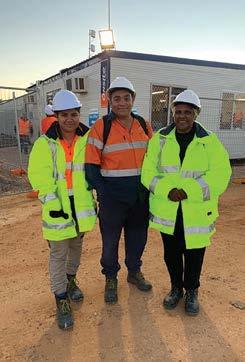
Tyra Lee Motto, Lillian Charles and Christine Abdulla at the South Australian Riverland Floodplains Integrated Infrastructure Program.
Specifically, more efficient watering of the Pike and Katarapko floodplains will help protect and restore key environmental and cultural assets.
Private construction corporation Fulton Hogan is contracted to undertake much of the infrastructure work for these projects. The projects are funded by the Common wealth Government and managed by the Department for Environment and Water in partnership with SA Water.
SA Native Title Services has been supporting RMMAC’s involvement in the project in several ways including through providing human resources, employment and payroll services.




